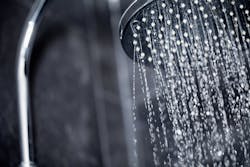The average American uses 80 to 100 gallons of water per day for activities such as showers, laundry and other household chores, according to the U.S. Geological Survey. Often, these activities take place at the same time, which can result in a drop in water pressure.
Many homeowners do not know how to fix these water pressure fluctuations, so they turn to professional dealers or installers for answers. What dealers may not realize is a variable frequency drive (VFD) is an effective and reliable solution.
A VFD monitors household water demand. Like the cruise control on a car, it speeds up or slows down the pump depending on household water requirements. The result is a constant stream of water where and when it is needed.
In addition to being an effective water solution, a VFD offers these benefits:
Extending equipment life. It protects the motor and pump in a conventional water system from running dry, going over current, short-circuiting or causing a ground fault.
Reducing energy consumption. Installing a VFD saves homeowners 50 percent of the energy required by a pump operating at full speed.
Minimizing mechanical and electrical stress. The drive gradually ramps the motor up to its operating speed to lessen mechanical and electric stress on the pumps. This soft-start feature reduces current in rush and heat, which protects the motor from fatigue and winding.
The drive can be installed in a new conventional water system or retrofitted for an existing conventional water system. VFDs are available with single-phase or three-phase motors.
Before installing a VFD, users should note that models have a maximum frequency switch that is used to energize the motor to either 60 or 80 Hertz (Hz). Use 60 Hz for match-pump motor combinations in which the motor and pump horsepower are the same. On the other hand, set the motor to 80 Hz for mismatched pump and motor combinations where the motor’s horsepower is larger than the pump’s horsepower, which is typically two times larger.
Installing a VFD in a new system
The first step to install the VFD is to properly size the water pump, taking into consideration well depth, demand and recovery rate. Some manufacturers have online selection tools to aid in choosing the proper pump model.
Once a dealer or installer has selected a VFD and the electrical power has been shut down, they should follow these five steps for installation:
- Hook up incoming power according to the manufacturer’s instructions.
- Connect output power to the well. The wires will be color coded, and the number of wires will depend on whether a single-phase motor or a three-phase motor is being installed. If a three-phase motor is being installed, make sure the motor is running in the proper counter clockwise rotation.
- Install the transducer. A transducer is the control for the drive and measures the pressure in the system.
- Adjust tank pressure. A new tank will typically be set at 38 psi. As a rule of thumb, a 20-psi differential should exist between the set pressure and the tank pressure. For example, if set pressure is 60 psi, the tank should be set at 40 psi. It is recommended that tank pressure be set at 30 psi for new installations. Note that the tank must be empty when setting the pressure.
- Adjust the motor overload setting dial to match the motor’s service factor amps. When the service factor amps are unknown, open the multiple fixtures/faucets at the same time and measure the output current with an amp meter to determine the current load. Failing to adjust the motor overload setting dial might damage the motor or wire. This could also void the product warranty.
Retrofit installations
Most retrofit installations will be single-phase output because the drive must match the system.
Before beginning the installation, make sure all water has been drained from the system. If water is in the tank, the pressure reading will be inaccurate and can cause cycling issues. Also, check the motor installation and wiring resistance to ensure that the motor and wire are in good condition.
After selecting the proper VFD, follow the directions for input and output wiring. When installing the transducer, disconnect the pressure switch from the pipe (tank tee). If an additional port is present, you can reconnect the pressure switch. If not, connect the transducer in the port where the pressure switch was located.
After adjusting the tank pressure and current overload, the system is ready to start.
The need for professional installers
Installing a VFD is not a do-it-yourself project. If it is not properly installed, the motor and pump will operate in adverse conditions, causing additional system damage or nuisance faults. As a result, the system can become inoperable and leave homeowners with no water. Additionally, many contractors, dealers and installers will not honor the product warranty if a homeowner installed the VFD in a conventional water system.
"It is important that a professional installs a VFD so that the job is done correctly the first time. Professional contractors and plumbers have undergone training and know how to troubleshoot and install the drives effectively," said Edward King, vice president of AquaFlow Pump & Supply.
Professional contractors are typically licensed, certified and educated on installation and the latest technologies. Some belong to professional associations that focus on providing education about recent innovations, products and industry trends. Some product manufacturers also offer ongoing training to professional contractors.
Image courtesy of Xylem Inc.
Chris Preston is a residential water product manager with expertise in submersible and jet pumps and residential pumping systems. For more than 10 years, he has worked for Xylem Inc. and its Goulds Water Technology brand as a product design engineer and project manager on multiple global new product development projects.



